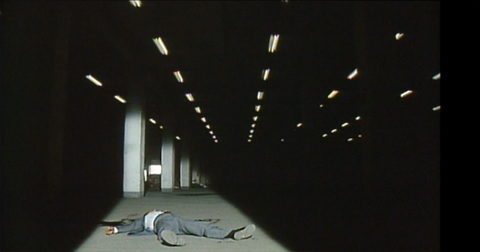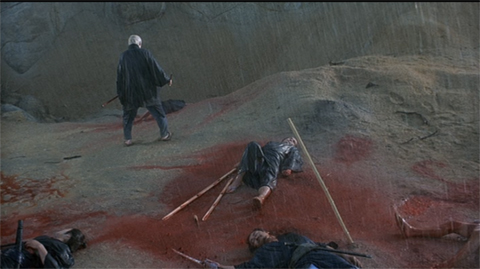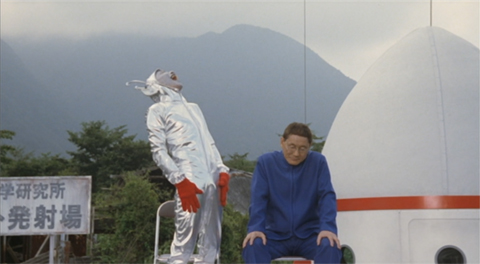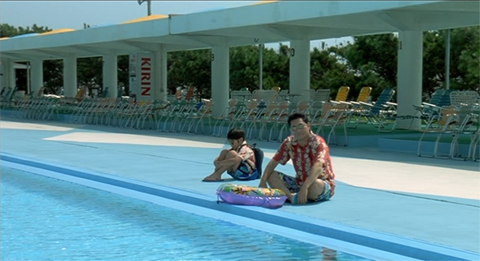As I gear up for ActionFest (April 7-10 in Asheville) where Takeshi Kitano’s newest film Outrage will be playing, I decided to spend a week looking back at how one of Japan’s most notable action film stars and directors got to where he is. The truth is, it’s a strange trip.
Kitano began his career as a comedian and I was introduced to him through his TV show Takeshi’s Castle when I lived in Japan. It was the kind of insanity that we loved about Japanese TV. Then he starred in and directed a dark yakuza film called Violent Cop and everything changed.
The Films
Violent Cop (1989) dir. Takeshi Kitano
Sonatine (1993) dir. Takeshi Kitano
Fireworks (1997) dir. Takeshi Kitano
Dolls (2002) dir. Takeshi Kitano
Kantoku – Banzai (2007) dir. Takeshi Kitano
Kikujiro (1999) dir. Takeshi Kitano
The Blind Swordsman: Zatoichi (2003) dir. Takeshi Kitano
If good comedy always comes from pain, then Takeshi Kitano’s career might just be some of the best proof anyone has of that maxim. His comedy is dark, often sadistic and based on the idea that people will put up with a lot of abuse for the sake of a laugh. Then again, his dramatic films are mostly tragic bordering on bleak, with recurrent themes of suicide, senseless death, and the tragedy of love. He is drawn to amoral figures in no-win situations, and his crime films like Violent Cop and Sonatine can be downright depressing. I get the sense that he’s just not a very happy guy.
Kitano rarely looks like a happy guy in any of these movies. In a few of them, he hardly says a word, opting instead to let his stoic demeanor and occasional outbursts of violence do all of the talking. Even when he’s poking fun at himself as in the brilliantly meta Kantoku – Banzai (Glory to the Filmmaker!) he plays a man of complete inaction to whom things, good and bad, simply happen. This seems like a strange role for a man who is himself an accomplished comedian, author, poet, painter, actor, director, and film editor. I didn’t see any music credits for Kitano but I wouldn’t be surprised if he had that in him too.
Zatoichi, the blind stoic swordsman is in a way the perfect role for Beat Takeshi. He doesn’t speak much, never has to open his eyes, and he simply kicks all kinds of ass when called upon. Kitano the director does a wonderful job of adding layers of moral ambiguity and mixed motivations for all of the characters in The Blind Swordsman: Zatoichi. It’s also beautifully shot. With the exception of the digital squibs and swords, it’s a pretty exquisite thing to watch.
But that deft use of color wasn’t always part of Kitano’s reportoire. In fact, Kitano mentions in an interview that he filled Dolls with the colors of the seasons as a kind of reaction to his critics who thought that his films were too monochromatic. Dolls is indeed bursting with color–the green of summer gives way to red autumn leaves, then a whitewashed winter. It’s his most obviously stylized film in this bunch, but despite his critics Kitano is certainly a visual stylist. His use of light and shadow in his crime films is appropriate for their tone. If those films look kind of ugly, well, that reflects the characters and the world they inhabit quite well. Kitano works with long shots that linger, allowing the viewer to reflect before moving on to a new shot.
Kitano pokes fun at himself and at movie making in general in the meta-textural collage film Kantoku – Banzai (Glory to the Filmmaker!) Banzai doesn’t make a lot of sesne without the context of Kitano’s other films under your belt, but it’s full of wry observations and Kitano’s own meandering self-doubt about his worth as a filmmaker and his place in Japanese cinema. This is another colorful film and one that’s full of humor although he often spends more time than I’d like setting up a very subtle punchline.
But out of this batch of films, my favorite was the one least like the others: Kikujiro. Beat Takeshi plays the world’s least likely father figure as he gets stuck trying to take a young boy to see his absent mother. It’s not a sugary film by any means–there’s plenty of darkness and misery–but Kitano seems to be in a hopeful mood with Kikujiro. It’s a “making lemonade out of lemons” kind of story, but Kitano’s weight as a purveyor of heavy, grim material makes it work. Once again it’s a beautifully-shot film with fantastic dream sequences and long, carefully-composed shots that sell the emotional content of each scene. I loved it.
Next stop is ActionFest where I get to see Kitano’s newest and a retrospective screening of Battle Royale!
Other Movie Weeks in 2011:
Atlanta Week
French Action Week
Childhood Fascination Week
Australian Rules Week
Black History Week
Vampire Week
Recent Westerns Week
Non-Godzilla Kaiju Week
Woody Allen Week
Secret Agent Week
Asian Action Week




